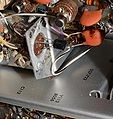422: Difference between revisions
No edit summary |
No edit summary |
||
| Line 1: | Line 1: | ||
{{Oscilloscope Sidebar | | |||
title=Tektronix 422 | | |||
summary=15 MHz portable dual-trace scope | | |||
image=Tek 422 front.jpg | | |||
caption=Tektronix 422 front | | |||
years=? | | |||
manuals= | |||
* [http://w140.com/tek_422.pdf Tektronix 422 Manual (PDF)] | |||
* [http://w140.com/tek_422_ac_powersupply.pdf Tektronix 422 Manual, AC power supply (PDF)] | |||
* [http://exodus.poly.edu/~kurt/mmm/tek-422.pdf Tektronix 422 Manual with AC/DC Power Supply (PDF)] | |||
* [http://w140.com/tek_422_low_sn.djvu Tektronix 422 Manual (low sn, DjVu)] | |||
* [http://w140.com/tek_422_sn_20000_up.pdf Tektronix 422 Manual for Serial Numbers 20,000 and up (PDF)] | |||
* [http://w140.com/tek_422_product_reference_book.pdf Tektronix 422 Product Reference Book (PDF)] | |||
}} | |||
The Tektronix Type 422 is a 15 MHz portable dual-trace oscilloscope. It was available with | The Tektronix Type 422 is a 15 MHz portable dual-trace oscilloscope. It was available with | ||
an optional battery back for operation without mains power. Early versions use an | an optional battery back for operation without mains power. Early versions use an | ||
| Line 10: | Line 24: | ||
feedback) and low gain for large signals (strong negative feedback). Thus, the signal at the base | feedback) and low gain for large signals (strong negative feedback). Thus, the signal at the base | ||
of Q364 has a limited swing over a wide range of input amplitudes. The collector current of Q364 | of Q364 has a limited swing over a wide range of input amplitudes. The collector current of Q364 | ||
varies between 0 and | varies between 0 and 9 mA. Depending on the position of the trigger slope control, higher collector | ||
current in Q364 either switches D375 from the low-voltage state to the high-voltage state or from the | current in Q364 either switches D375 from the low-voltage state to the high-voltage state or from the | ||
high-voltage state to the low-voltage state. When D375 transitions from the low-voltage state to the | high-voltage state to the low-voltage state. When D375 transitions from the low-voltage state to the | ||
| Line 19: | Line 33: | ||
The 8056 Nuvistor used in the input amplifier of the 422 can be replaced by a [[MPF102]] JFET. | The 8056 Nuvistor used in the input amplifier of the 422 can be replaced by a [[MPF102]] JFET. | ||
==Specifications== | |||
==Pictures== | |||
<gallery> | <gallery> | ||
| Line 50: | Line 61: | ||
File:Wellenkino 422.jpg | File:Wellenkino 422.jpg | ||
</gallery> | </gallery> | ||
[[Category:400 series scopes]] | |||
Revision as of 11:35, 11 May 2014
The Tektronix Type 422 is a 15 MHz portable dual-trace oscilloscope. It was available with an optional battery back for operation without mains power. Early versions use an 8056 Nuvistor tube for the front-end cathode follower. Later versions use a FET front end. The 422 uses tunnel diodes for triggering. The post-deflection acceleration voltage is 4900 Volts.
The trigger circuit in the 422 has a trigger amplifier driving a 1N3719 tunnel diode, D375, which acts as a Schmitt trigger. The trigger amplifier has a nonlinear deadband diode circuit in the negative feedback path. What results is high gain for small signals (little or no negative feedback) and low gain for large signals (strong negative feedback). Thus, the signal at the base of Q364 has a limited swing over a wide range of input amplitudes. The collector current of Q364 varies between 0 and 9 mA. Depending on the position of the trigger slope control, higher collector current in Q364 either switches D375 from the low-voltage state to the high-voltage state or from the high-voltage state to the low-voltage state. When D375 transitions from the low-voltage state to the high-voltage state, it produces a current pulse in the primary of transformer T401, which produces a current pulse in the secondary of T401. The secondary of T401 feeds another tunnel diode, D405, and the current pulse switches D405 to the high-voltage state, which starts a sweep.
The 8056 Nuvistor used in the input amplifier of the 422 can be replaced by a MPF102 JFET.
Specifications
Pictures
-
-
-
Trigger circuit
-
Sweep circuit
-
Vertical amplifier circuit
-
Input amplifier circuit
-
Horizontal amplifier circuit
-
CRT circuit
-
-
-
-
-
-
-
-
-
-
-
ac-dc power supply
-
ac power supply
-






















